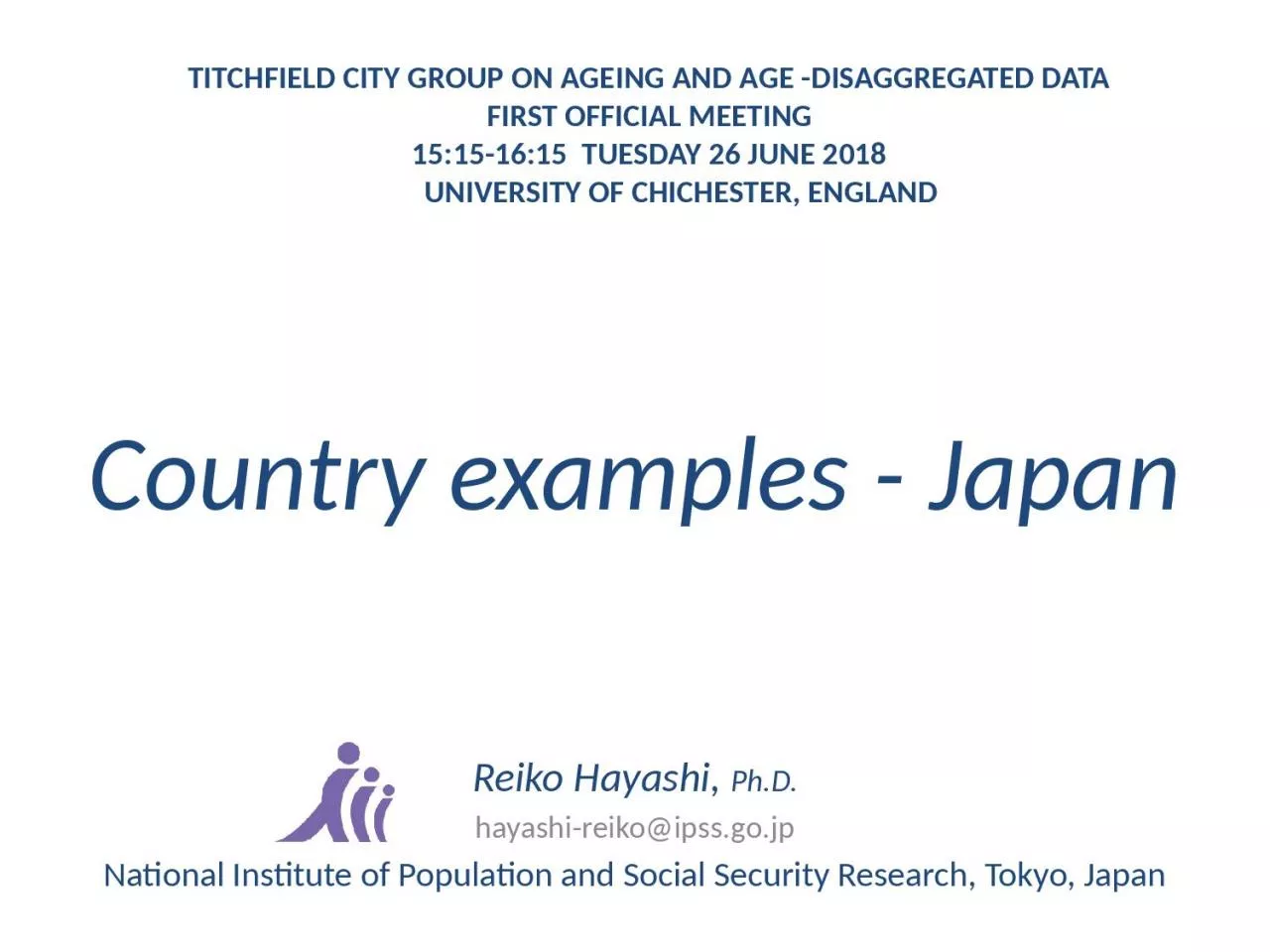

Reiko Hayashi PhD hayashireikoipssgojp National Institute of Population and Social Security Research Tokyo Japan TITCHFIELD CITY GROUP ON AGEING AND AGE DISAGGREGATED DATA FIRST OFFICIAL MEETING ID: 1042400
Download Presentation The PPT/PDF document "Country examples - Japan" is the property of its rightful owner. Permission is granted to download and print the materials on this web site for personal, non-commercial use only, and to display it on your personal computer provided you do not modify the materials and that you retain all copyright notices contained in the materials. By downloading content from our website, you accept the terms of this agreement.
1. Country examples - JapanReiko Hayashi, Ph.D.hayashi-reiko@ipss.go.jpNational Institute of Population and Social Security Research, Tokyo, JapanTITCHFIELD CITY GROUP ON AGEING AND AGE -DISAGGREGATED DATAFIRST OFFICIAL MEETING15:15-16:15 TUESDAY 26 JUNE 2018 UNIVERSITY OF CHICHESTER, ENGLAND
2. Award for centenarianAward created in 1963 as the event of the Respect for the Aged Day (3rd Monday of September) Silver cup offered by Prime Minister32,097 centenarians received in 2017 (total number of centenarian was 67,824) Dissemination of information The centenarian name list was created > not any more (since 2016, there are too many!) http://wadaya.ocnk.net/product/49
3. Statistics Bureau’s compilation on statistics related to the older person on the occasion of the Respect for the Aged Day on 19 September 2016Pick-up topics from various survey results already published by the Statistics Bureau CensusReport on Internal MigrationLabour Force Survey Family Income and Expenditure SurveyCommunications Usage Trend SurveySurvey of Household EconomyNumber of employed 65+ by gender 1989-2015Household consumption by categoryhousehold head -65 and 65+Statistics Topics No.97, Statistics BureauhousingElectricity, waterfurniture, household materialclothes shoes-65 HH head65+ HH headhealth food othercultureamusementeducationtransportcommunication(times)
4. Definition of the elderlySince 1950’s set at 65+, “according to the UN definition”Different age are used by different occasionFree medical care for the elderly 1973-1983 : 70+Late-stage medical care system for the elderly 2006- : 75+Pensionable age : gradually shifting from 60 to 65Retirement : used to be 55, below 60 prohibited in 1998, since 2004, companies have to provide measures for employment until 65, raise or abolish retirement ageThe definition proposed by the Japan Geriatrics Society : 75+
5. Highest age group2015 census (published table)each age group up to 110+5 age group up to 110+
6. Healthy life expectancy as the indicator of governmental policy frameworkHealth Japan 21 (the second term)Longer extension of healthy life expectancy compared to life expectancy from 2010 to 2022Smaller disparity among the 47 prefectures The Japan’s Plan for Dynamic Engagement of All CitizensExtension of healthy life expectancy more than 2 years from 2010 to 2025
7. Healthy life expectancy of Japan2001 to 2013 Source : “Health Japan 21 (the second term) Progress of each objective”, Ministry of Health, Labour and Welfare, http://www.mhlw.go.jp/file/05-Shingikai-10601000-Daijinkanboukouseikagakuka-Kouseikagakuka/sinntyoku.pdf
8. Comprehensive Survey of Living ConditionsQuestion on daily activity limitationIs your daily life affected by the health problem at present?1.Yes 2.NoExactly the same text of question since 1989Large sample size (around 300,000 households) conducted every 3 yearsDisaggregated by sex, age, prefecture…Used as an indicator in national policyQuestionnaire of 2013
9. Various longitudinal surveys in JapanJAHEAD : Japanese Study of Assets and Health Dynamics among the Oldest Old, conducted by a joint research group with University of Michigan, the University of Tokyo (Prof.Hiroko Akiyama and Prof.Tetsuo Tsuji) and Tokyo Metropolitan Health and Longevity Medical Center Research Institute. 8 surveys were conducted since 1987 to 2012. http://www2.tmig.or.jp/jahead/index.htmlNUJLSOA : Nihon University Japanese Longitudinal Study of Aging lead by Prof.Yasuhiko Saito, Nihon University. The first wave survey was conducted in 1999, second in 2001, third in 2003 and the data are available in ICPSR.https://www.icpsr.umich.edu/icpsrweb/NACDA/studies/156Longitudinal Survey of Middle-aged and Elderly Persons : Conducted by the Ministry of Health, Labour and Welfare since 2005, targeting the baby boomer, randomly sampled 34,240 persons aged 50 to 59 in 2005. For the 12th year in 2017, the sample reduced to 21,916 persons.JAGES : Japan Gerontological Evaluation Study, lead by Prof. Katsunori Kondo of Chiba University. Started in 2003 in Aichi prefecture, this survey is organized in collaboration with interested municipalities, now covering 160,000 persons in 39 municipalities across Japanhttps://www.jages.net/JSTAR : Japanese Study of Aging and Retirement, started in 2007 by RIETI(Research Institute of Economy, Trade and Industry) and Hitotsubashi University to produce the data comparable with Health and Retirement Study (HRS, USA)、Survey of Health, Aging and Retirement in Europe (SHARE, continental Europe)、English Longitudinal Study of Aging (ELSA, Britain)https://www.rieti.go.jp/jp/projects/jstar/This survey is included in the “Gateway to Global Ageing Data” https://g2aging.org/
10. Promotion of active ageing andactive ageing indicatorsComposed of 25 indicators in 6 fieldsNational/Local Government policy (2)Income security (2)Social Capital of Community (5)Health and Long term care service (7)Health Outcome (5)Development of Social Statistics (4)3rd ASEAN –JAPAN ACTIVE AGING CONFERENCE held in Manila in June 2017 organized by the Ministry of Health Labour and Welfare, Japan, and Asian Development BankMany similar sets of indicators elsewhere and how to harmonize?
11. Development of health and long term care system through enhanced skills(+ ODA, PPP…)Asian-wide development of care personnel through circular migrationReturn MigrationInnovative care technology (System, ICT, Robot)EPA Education TrainingInternshipAsia Health and Wellbeing Initiative (AHWIN)A Regional Strategy for Healthy Ageingsince July 2016
12. Collaboration on the waylongitudinal surveys on ageing in South East AsiaPhilippines (ERIA/AHWIN)Vietnam (ERIA/AHWIN)Myanmar (AMED)Malaysia